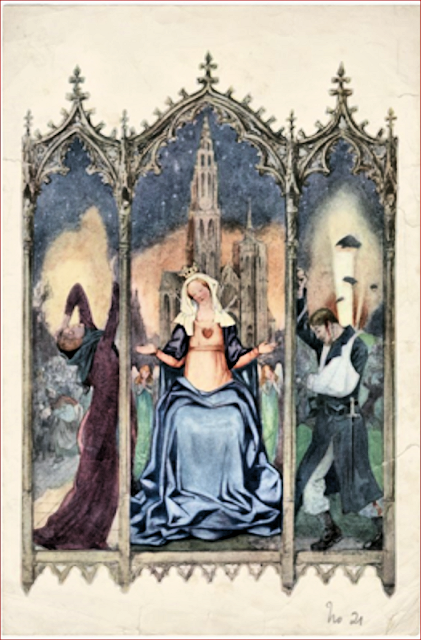U.S. St. Mihiel Cemetery
St. Michael was considered the leader of the heavenly army, often depicted with a sword, symbolizing the fight against evil. Use of Christian saint and Virgin Mary imagery to inspire action and foster hope in war dates back centuries, though mass production and public consumption of such images began during the First World War. They expressed patriotic and religious confidence in a righteous cause—as well as being useful tools for inspiring others to give in support of the effort. Most of the examples I've found, naturally, are from Catholic and Orthodox countries. This mosaic was created postwar at the American cemetery in France.
Our Lady of Antwerp
by Louis Raemaekers
An altar piece design with wounded virgin, and Antwerp being destroyed in background. "Here I and sorrows sit. This is my throne, bid Kings come worship it." Such seems to be an appropriate legend for Raemaekers's beautiful triptych which he has entitled "Our Lady of Antwerp." Full of compassion and sympathy for all the sufferings of her people, she sits with the cathedral outlined behind her, her heart pierced with many agonies. On the left is one of the many widows who have lost their all in this war. On the right is a soldier stricken to death, who has done his utmost service for his country and brings the record of his gallantry to the feet of Our Lady of Antwerp.
Virgin Mary with Polish Soldiers
by Wladyslaw "W. T." Benda
This was placed on a Certificate of Donation issued by the Polish National Department, Polish Central Relief Committee It is depicting Polish soldiers marching into a fiery and smoke-filled battlefield near a church, with the Virgin Mary and Child Jesus appearing in the sky above. This work is bordered by a motif featuring hearts, flowers, and the Christian cross.
Saints, particularly those with a militant penchant such as Joan of Arc, were also widely called upon by the nations at war for support and inspiration
Saint Joan of Arc Saved France
by Haskell Coffin
In this wartime poster supporting the U.S. savings stamp program, Joan of Arc is ready to fight, with her sword unsheathed and her face lifted upward in optimistic bravery.
Go Away
Unknown Artist
Black-and-white postcard in French of a scared German soldier dropping his weapon as he looks at Joan of Arc, in her armor with sword drawn and a saint's halo surrounding her head.
St. Therese of Lisieux (The Little Flower)
Visiting a Wounded Poilu
Unknown Artist
There were, apparently, a number of illustrations produced with this theme. St. Thérèse was a French nun who died of tuberculosis at age 24 in 1897. She left a beloved manuscript, The Story of a Soul, which which gained great popularity in France. Pope Pius X signed the decree for the opening of her process of canonization on 10 June 1914. She was the best-known religious figure to the generation of French soldiers who would fight in the trenches.
After the First World War broke out, St. Thérèse over 40 French soldiers claimed she had appeared to them and comforted them on various battlefields in France. The soldiers said she spoke to them matter-of-factly, resolved their doubts, helped them overcome their temptations, and calmed their fears. Thousands of French soldiers carried her photo and invoked her as “my little sister of the trenches,” “the shield of soldiers,” “the angel of battles,” and “my dear little Captain.” A soldier wrote, “In fact, that gentle Saint will be the great heroine of this war.” Another commented, “I think of her whenever the cannons thunder.” Countless were the artillery pieces and planes named after her; whole regiments were consecrated to her. Medals of the saint given to the soldiers miraculously stopped rifle bullets like real shields, saving the lives of the soldiers who carried them (some of these medals, as well as letters from the men) are now preserved in the cloister in Lisieux). Thérèse was beatified in 1923 and canonized in 1925.
Sources: "Religious Icons in Art and War"; The National World War I Museum; The Life of St. Therese of Lisieux Website







Interesting bit of trivia about St. Thérèse of Lisieux and WWI: The 'Bells of Peace', a 405 tone Schulmerich Carillon that was donated by Hallmark's founder and installed in the Liberty Memorial Tower in Kansas City, was re-installed at St. Thérèse Shrine of the Little Flower Church in 2012.
ReplyDeleteThanks Jim. Interesting detail.
Delete